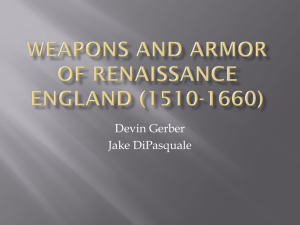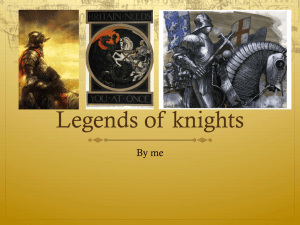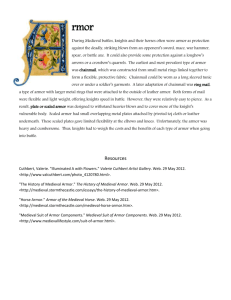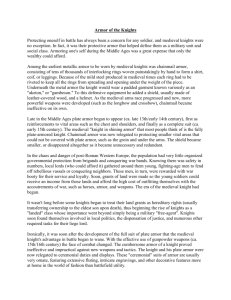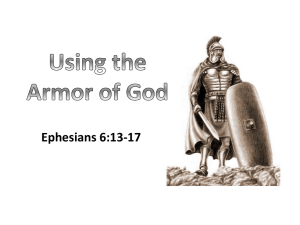HUSSAR ARMOR - Suligowski`s Regiment Polish Winged Hussars
advertisement
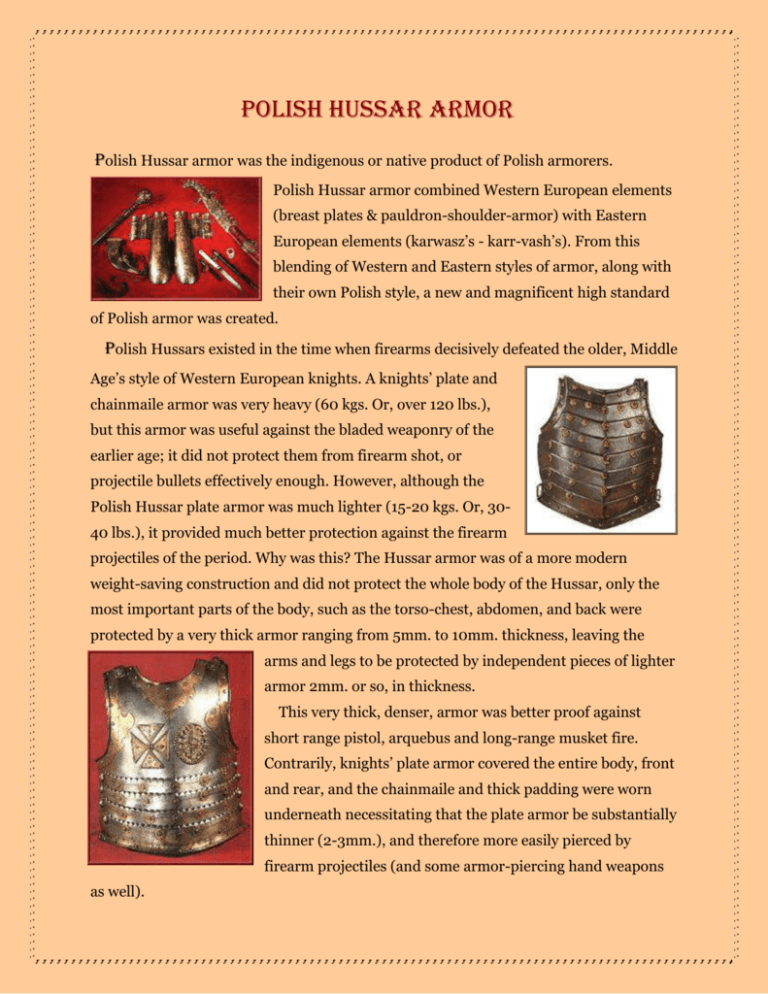
Polish HUSSAR ARMOR Polish Hussar armor was the indigenous or native product of Polish armorers. Polish Hussar armor combined Western European elements (breast plates & pauldron-shoulder-armor) with Eastern European elements (karwasz’s - karr-vash’s). From this blending of Western and Eastern styles of armor, along with their own Polish style, a new and magnificent high standard of Polish armor was created. Polish Hussars existed in the time when firearms decisively defeated the older, Middle Age’s style of Western European knights. A knights’ plate and chainmaile armor was very heavy (60 kgs. Or, over 120 lbs.), but this armor was useful against the bladed weaponry of the earlier age; it did not protect them from firearm shot, or projectile bullets effectively enough. However, although the Polish Hussar plate armor was much lighter (15-20 kgs. Or, 3040 lbs.), it provided much better protection against the firearm projectiles of the period. Why was this? The Hussar armor was of a more modern weight-saving construction and did not protect the whole body of the Hussar, only the most important parts of the body, such as the torso-chest, abdomen, and back were protected by a very thick armor ranging from 5mm. to 10mm. thickness, leaving the arms and legs to be protected by independent pieces of lighter armor 2mm. or so, in thickness. This very thick, denser, armor was better proof against short range pistol, arquebus and long-range musket fire. Contrarily, knights’ plate armor covered the entire body, front and rear, and the chainmaile and thick padding were worn underneath necessitating that the plate armor be substantially thinner (2-3mm.), and therefore more easily pierced by firearm projectiles (and some armor-piercing hand weapons as well). The Polish Hussar armor was also much more ergonomic and flexible to a point. That is, the lower parts of the torso breastplate around the abdomen consisted of individual bands (lames) or segments called ‘folga’ in Polish, that gave some elasticity to the armor and made it easier for the Hussar to twist and bend forward his body if necessary. This lower segmented part of the hussar’s armor is very similar to the ancient Roman ‘lorica segmentata’ legionary armor, and there exists some clear discussion, depicting some evolutionary influence as such. Western knights’ armor was more rigid and restrictive, and made it much more difficult and limiting to move around in while wearing it. Hussar armor although started out simply decorated, eventually became much more elaborately decorated with fine, brass stamped edging, fittings, rosettes and scalloping, and some beautifully etched patterns, usually surpassing most knights’ armor in beauty and presentation. Classical and fully developed Polish Hussar armor can be categorized as being of two different time periods, early and late (‘Older’ and ‘younger’). The early period armor was popular from about 1630-1675, while the later Hussar armor was from approximately 1675-1775. Overall, there was not that many differences in construction, however, the later period armor tended to be more decorative and ostentatious in appearance, as the armor makers fine-tuned their craft, suiting the wants and needs of the pocket-costs of the individual Hussars competing with each other for opulence. However, both periods of Hussar armor gave equally superb protection to the Hussar. The first and most notable feature of Hussar armor is the towering pair of beautiful wings, or, single wing affixed to the backplate. These wings were decorative, but were also a powerful psychological warfare weapon in and of themselves. They gave the Hussar the appearance of being larger-than-life compared to the average cavalry horseman of the day, and the wings were alleged to have made varying sounds of buzzing as the wind whistled thru them which terrified both the enemy horses and the enemy themselves. Although the Hussar’s swirling and popping lance-pennants and flapping shoulder animal-skin capes contributed to this overall intimidating appearance, the ‘buzzingwings’ topic is hotly contested to this very day. Why? Because no one living, can actually verify if the enemy horses across the battlefield can actually hear the buzzing wings through the cacophony of war; the thundering hooves of the charge, roaring cannons, cracking musket-fire, clanking armor, etc. Horses can only charge at a specific speed for a limited time and space, further the conditions must be so specific as to see and hear if the wings can be recreated to give the sounds as some have described. * The very long pennants and expensive animal skins, such as leopard, tiger, wolf, and bear skins had the same demoralizing effect upon the enemy and their horses. * (One example can be conclusively proven by eye-witness’s; that the sheer sight of the towering wings to the eyes and senses of a horse untrained to accept such a sight, often can, and will, cause some percent of sensory-overload and cause the horse(s) to panic and want to run away, whether the rider has control or not! Contemporary accounts verify it. This fact has been proven even in modern times. Participation in a military timeline event in southern California, and during a quiet pause in a parade, while standing near horses, the wind did, in fact, pick up enough to cause the feathers of a (modern) Polish Winged Hussar re-enactors’ ‘wings’ to vibrate and buzz, causing some very noticeable concern to those nearby horses, enough of which, gave their riders cause to calm the apprehensive horses down immediately. Some horses have even spun away from the sight of the winged armor, throwing themselves into other nearby horses. This happened before many eye-witness’s). Article courtesy of Radoslaw Sikora ©, 02/17/2002, and amended with additional supplementary material by Rik Sulima-Suligowski Fox 10/08/2005. Other sources: “HUSARIA” (The Polish Hussar Cavalry) Cichowski, Jerzy/Szulczynski, Andrzej, Pub. Dom Wydawniczy Bellona, Warszawa 2004 “HUSARIA POLSKA” (The Polish Hussars) Zygulski jun., Zdzislaw Pub. Wydawnictwo ‘Pagina’ Warszawa 2000 “STARA BRON w POLSKICH ZBIORACH” (Old Armor & Weapons in Polish Collections) Zygulski Jun., Zdislaw Pub. Warszawa 1984 “HUSARZE, UBIOR, OPORZADZENIE I UZBROJENIE, 1500-1775” (Hussar Uniforms, Equipment & Weapons from 1500-1775) Gembarzewski, Branislaw Pub. Wydawnictwo ‘Arcadia’ Warszawa 1939/2000 “HUSARIA- THE WINGED HORSEMEN” Wasilkowska, Anna Pub. Wydawnictwo Interpress 1998 “BRASSEY’S BOOK of UNIFORMS” Newark, Tim Pub. Brassey’s UK Ltd. 1998 “A BOOK of MILITARY UNIFORMS and WEAPONS” (An Illustrated Survey of Military Dress, Arms & Practice through the Ages- Ancient Egypt -post-Napoleonic Wars) Toman, Karel Pub. Paul Hamlyn & Allan Wingate-London Westbook House 1964 Czechoslovakia “POLSKIE SILY ZDROJNE w CIAGU WIEKOW” (Polish Armed Forces thru the Ages) Dziewanowski, W. / Minkiewicz, A. / Paintings: Pacewicz, K. Forward: Lt. Gen. M. Kukiel K.C.B. Pub. “Orbis” Polish Travel Office/Polish Ministry of National Defense, London 1944 “BRON WODZOW I ZOLNIERZY” (Armor & Weapons of Commanders & Soldiers) Zygulski jun., Zdislaw, Pub.Wydawnictwo Kluszczynski 2005/06 “RZECZPOSPOLITA SARMATOW” (Sarmatian Commonwealth) Grzybek, Dariusz/Marcinek, Roman/Maslanka, Julian Pub.Wydawnictwo Kluszczynski 2005/06 “LAND OF THE WINGED HORSEMEN / ART IN POLAND 1572-1764”Ostrowski, Jan K. Pub. Art Services Int’l. 1999 Photo of Nigel Carren’s hussar armor ©, courtesy of the Imperial War Museum, London. * Los Angeles, California’s Annual Fort McArthur Military Timeline’s 2003-4-5-6 & 7!


